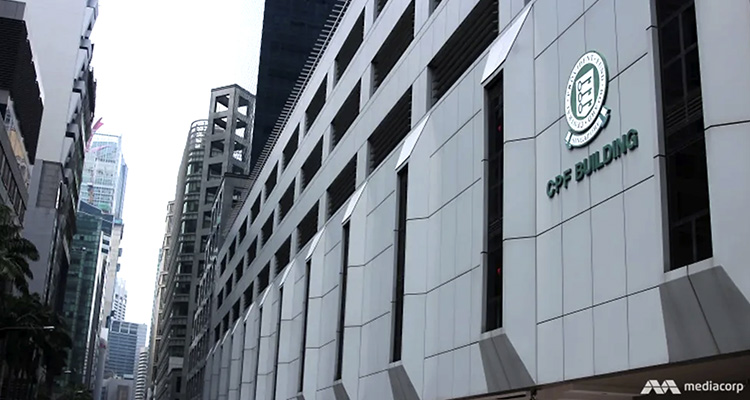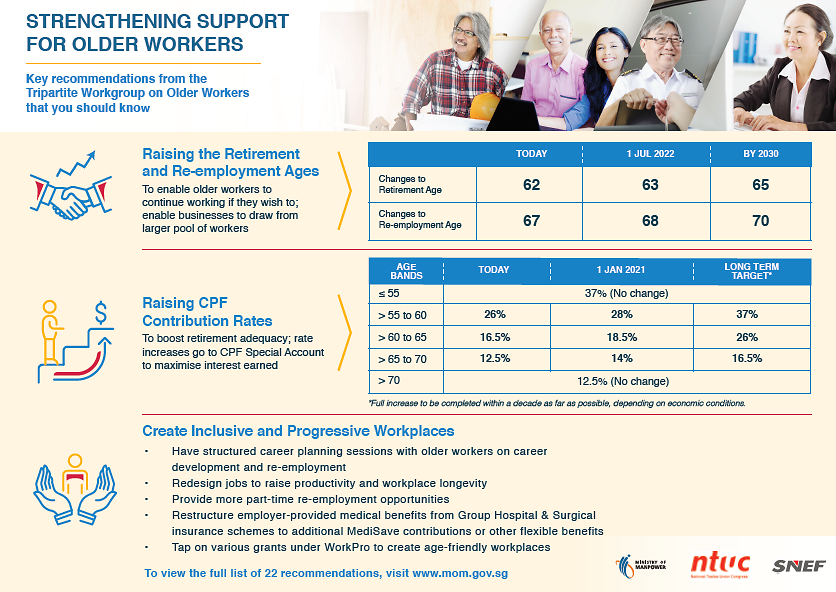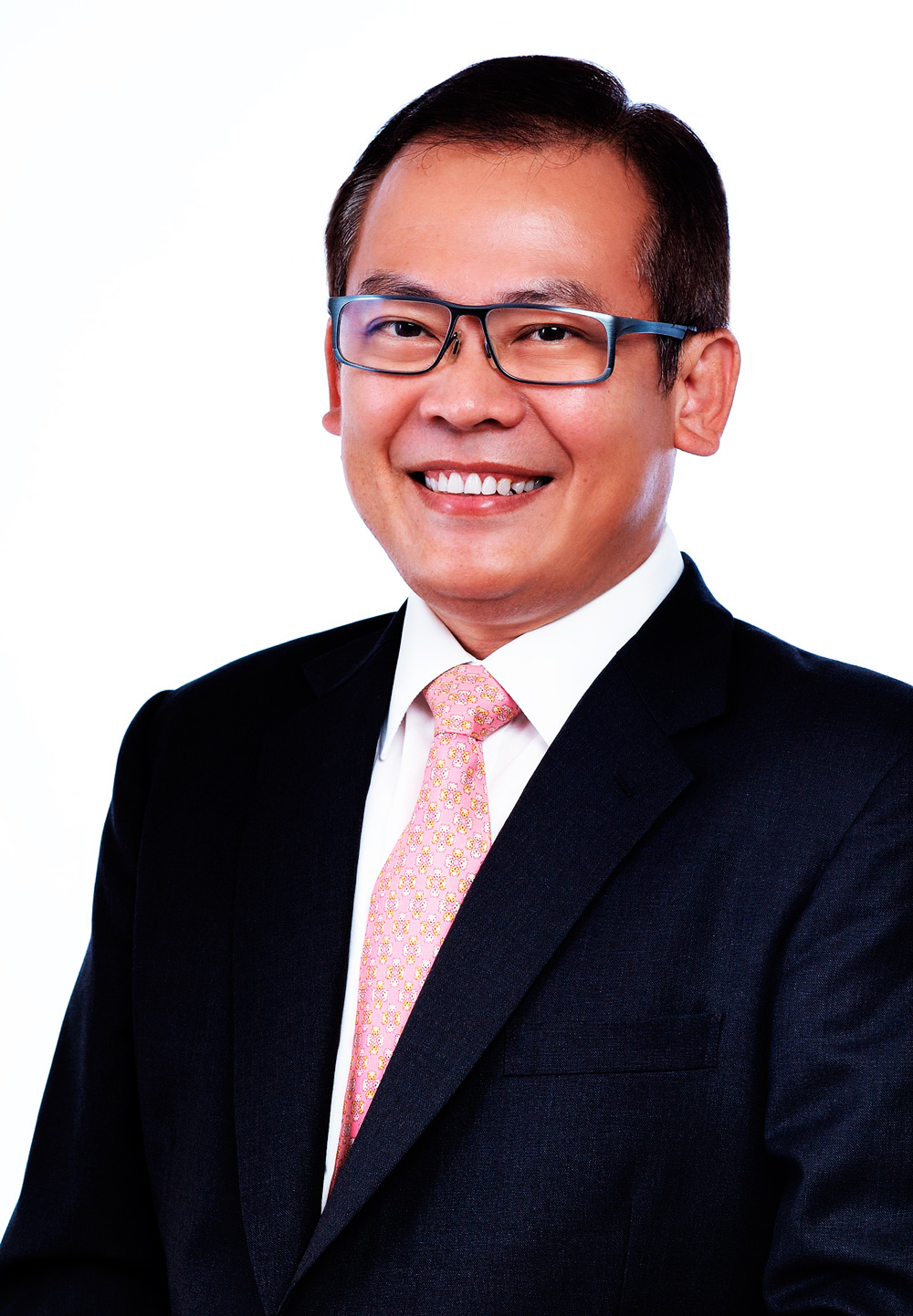Full restoration of CPF contributions for those aged 55 to 60; higher rates for workers above 60

SINGAPORE: In a long-term move aimed at helping older Singaporeans build up their retirement funds, the Central Provident Fund (CPF) contributions for those aged above 55 to 60 will be raised by 11 percentage points to 37 per cent – on par with that of the younger workers – over the next 10 years or so.
This follows the Government’s acceptance “in full” of the 22 recommendations put out by a tripartite workgroup on older workers.
NDR 2019: New retirement, re-employment ages of 65 and 70 by 2030; higher CPF contributions for older workers
Providing details of its recommendations, the workgroup on Monday (Aug 19) said rates for those aged above 60 to 70 should go up by “smaller but meaningful” amounts over the same period, with a stepped reduction by age bands remaining in place.
This means an increase of 9.5 percentage points to 26 per cent for those aged above 60 to 65, and a rise of 4 percentage points to 16.5 per cent for those above 65 to 70.
The total CPF contribution rate remains unchanged at 12.5 per cent for workers above 70 years old.

The workgroup, comprising representatives from the Government, employers and unions, also suggested raising the statutory retirement age from 62 to 65, and the re-employment age from 67 to 70, gradually by 2030.
HOW FAST: FIRST CHANGE IN 2021
Currently, the total CPF contribution rate – including those from employers and employees – is 37 per cent for workers up to 55 years old.
It drops progressively as the age band increases – 26 per cent for workers aged 55 to 60, 16.5 per cent for those aged 60 to 65, and 12.5 per cent for those beyond 65.
To boost retirement adequacy for older workers, the first incremental adjustment in CPF rates should kick in on Jan 1, 2021, the workgroup said.
This will see contributions go up to 28 per cent for workers aged above 55 to 60. Workers in the next age band – above 60 to 65 – will see their rates go up to 18.5 per cent, while those above 65 to 70 will have a higher rate of 14 per cent. There will be no change for those above 70.
Employers and workers will each have to increase their contributions by 1 percentage point, except for the age band of above 65 to 70. For this group, employee contribution is set to rise by 1 percentage point while that from the employer will go up by just 0.5 percentage point.
This change in 2021 will apply to cohorts born on or after January 1951.

Subsequent increases should be made gradually, with each move kept within 1 percentage point for either workers or employers, the workgroup said in its report.
And while the full adjustment is set to be rolled out within a decade, there should also be “flexibility to stretch the timeline beyond 2030 if necessary”.
It suggested monitoring the outcomes before finalising subsequent hikes, taking into account prevailing economic and labour market conditions.
“In some years, there may be a need to defer the contribution rate increases in order to relief pressure on business and moderate the impact on workers’ take-home pay,” it added in the report.
Mr Lee, in his NDR speech, had mentioned that employers were concerned about costs given the uncertain economic outlook.
HOW MUCH TO RAISE RATES
The workgroup has suggested all additional contributions to be “fully allocated” to the Special Account (SA), which has higher interest rates than the Ordinary Account (OA).
Based on “conservative estimates” of 4 per cent and 2.5 per cent base interest rates for savings in the SA and OA respectively, a worker earning S$2,900 from age 55 to 65 will have an additional S$47,300 in the SA.
NDR 2019: Labour movement MPs, NMPs give their views on higher CPF contribution rates for older workers
This is S$3,600 more than if the contributions were allocated to the OA, it said.
As for the quantum of increases, the workgroup said it recommended a steeper hike in rates for those aged above 55 to 60 as the employment rate for this group of workers has improved “significantly” to 72.7 per cent last year, from 64.2 per cent in 2008.
A rise in CPF rates is hence not expected to reduce the employability of these workers.
However, “smaller but meaningful” increases will be necessary for those aged 60 to 70, so that there is “lower risk of reduced employability and take-home pay”, it said.
As to why CPF rates are levelled off above 70 years old, the report wrote: “This as employers have no obligation to re-employ workers beyond the age of 70. Raising CPF contributions risks making these workers less employable with no significant gains in retirement adequacy.”
The workgroup also explained why it did not recommend equalising CPF contribution rates to 37 per cent for all age groups.
“Such a large increase would severely affect the take-home pay for the worker, and raise business costs for the employer,” the report said.
“It will be more practical to maintain different rates for different age bands but start tapering CPF contribution rates at a later age than 55,” it added.
Prior to 1988, all workers in Singapore received the same CPF contribution rates regardless of age.
Rates for older workers were reduced in 1988 to improve their employability at a time when seniority-based wage practices were prevalent. The rates became tiered according to age, with CPF rates lowered for older age groups.
In response to economic conditions and to protect employability, contribution rates were also reduced in 1999 for workers aged 55 to 65, and in 2005 for those aged 50 to 65.
The last adjustment was in 2016, when the CPF rates for workers aged 50 to 55 were equalised with that of younger age groups as their employability improved.
[SOURCE: https://www.channelnewsasia.com/news/singapore/cpf-contribution-rates-older-workers-ndr-2019-national-day-rally-11822276]






